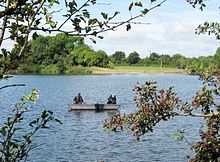Tring Reservoirs
| Site of Special Scientific Interest | |
 Startops End Reservoir | |
| Area of Search |
Hertfordshire Buckinghamshire |
|---|---|
| Grid reference |
SP919136 SP905131 |
| Interest | Biological |
| Area | 106.5 hectares |
| Notification | 1987 |
| Location map | Magic Map |
_-_geograph.org.uk_-_1413841.jpg)

Tring Reservoirs is the name for a group of four reservoirs close to Tring on the border Hertfordshire and Buckinghamshire, England. The purpose for their existence was to feed the Grand Union Canal.[1]
The four reservoirs are: Startops End, Marsworth, Tringford and Wilstone. These reservoirs adjoin each other, separated only by paths and roads; the fourth, Wilstone Reservoir, is a short distance to the west, close to the village of Wilstone.
The reservoirs are a 106.5 hectare biological Site of Special Scientific Interest[2][3] managed by the Herts and Middlesex Wildlife Trust.[4]
History
Wilstone Reservoir is the largest of the quartet at 119 acres, Built in 1802, is up to 18 feet deep and has a capacity of 240 million gallons. Wilstone reservoir supplies water to the Wendover arm of the Grand Union Canal.[5] Startops End Reservoir built in 1817 is much smaller at 26 acres, Marsworth Reservoir built in 1806 is 24 acres and the smallest Tringford Reservoir was built in 1816.[6] The reservoirs are popular to anglers and most famous for holding specimen wels catfish, as well as carp, tench, pike, roach, rudd, bream and European perch. Also rainbow trout in Tringford only.[7]
Waterfowl
Wilstone Reservoir is a very important wildfowl sanctuary and many rare species dwell here, as well as on the other 3 reservoirs. These include Atlantic Canada geese, bittern, blackcap, black-headed gull, black-necked grebe, black-tailed godwit, black tern, blue tit, Cetti's warbler, common chiffchaff, corn bunting, common crane, common sandpiper, common scoter, common snipe, common teal, common tern, coot, curlew, curlew sandpiper, dunlin, dunnock, Egyptian geese, Eurasian wigeon, gadwall, garden warbler, garganey, great crested grebe, great spotted woodpecker, green sandpiper, greenshank, green woodpecker, grey heron, greylag geese, hobby, jay, kingfisher, lapwing, lesser whitethroat, linnet, little egret, little grebe, little ringed plover, mallard, Mandarin, marsh harrier, marsh tit, Mediterranean gull, moorhen, mute swan, northern pochard, northern wheatear, nuthatch, osprey, oystercatcher, peregrine falcon, pied flycatcher, pintail, red-crested pochard, red kite, red knot, redshank, reed warbler, ruff, spotted flycatcher, sand martin, Savi's warbler, sedge warbler, shelduck, shoveler, sinensis cormorant, spotted crake, stock dove, swallow, swift, tawny owl, treecreeper, tufted duck, water rail, whimbrel, whooper swan, willow warbler, yellow-legged gull, yellow wagtail.[8][9]
There is an extensive network of public footpaths and canal towpaths.[10]
| Wikimedia Commons has media related to Tring Reservoirs. |
See also
- List of Sites of Special Scientific Interest in Buckinghamshire
- List of Sites of Special Scientific Interest in Hertfordshire
References
- ↑ "Tring Reservoirs".
- ↑ "Tring Reservoirs citation" (PDF). Sites of Special Scientific Interest. Natural England. Retrieved 13 January 2015.
- ↑ "Map of Tring Reservoirs". Sites of Special Scientific Interest. Natural England. Retrieved 13 January 2015.
- ↑ "Tring Reservoirs". Herts and Middlesex Wildlife Trust. Retrieved 19 April 2015.
- ↑ "Nature Reserve Tring".
- ↑ "Walks at Tring Reservoirs" (PDF). British Waterways. waterscape.com.
- ↑ "Tring Fishing".
- ↑ "Nature Reserve Waterfowl". Friends of Tring Reservoirs.
- ↑ "HNHS Wildlife Sightings Archive".
- ↑ "Maps, Walks and Links". Friends of Tring Reservoirs. Retrieved 13 January 2015.
External links
Coordinates: 51°48′47″N 0°40′05″W / 51.813°N 0.668°W
| ||||||||||
| ||||||